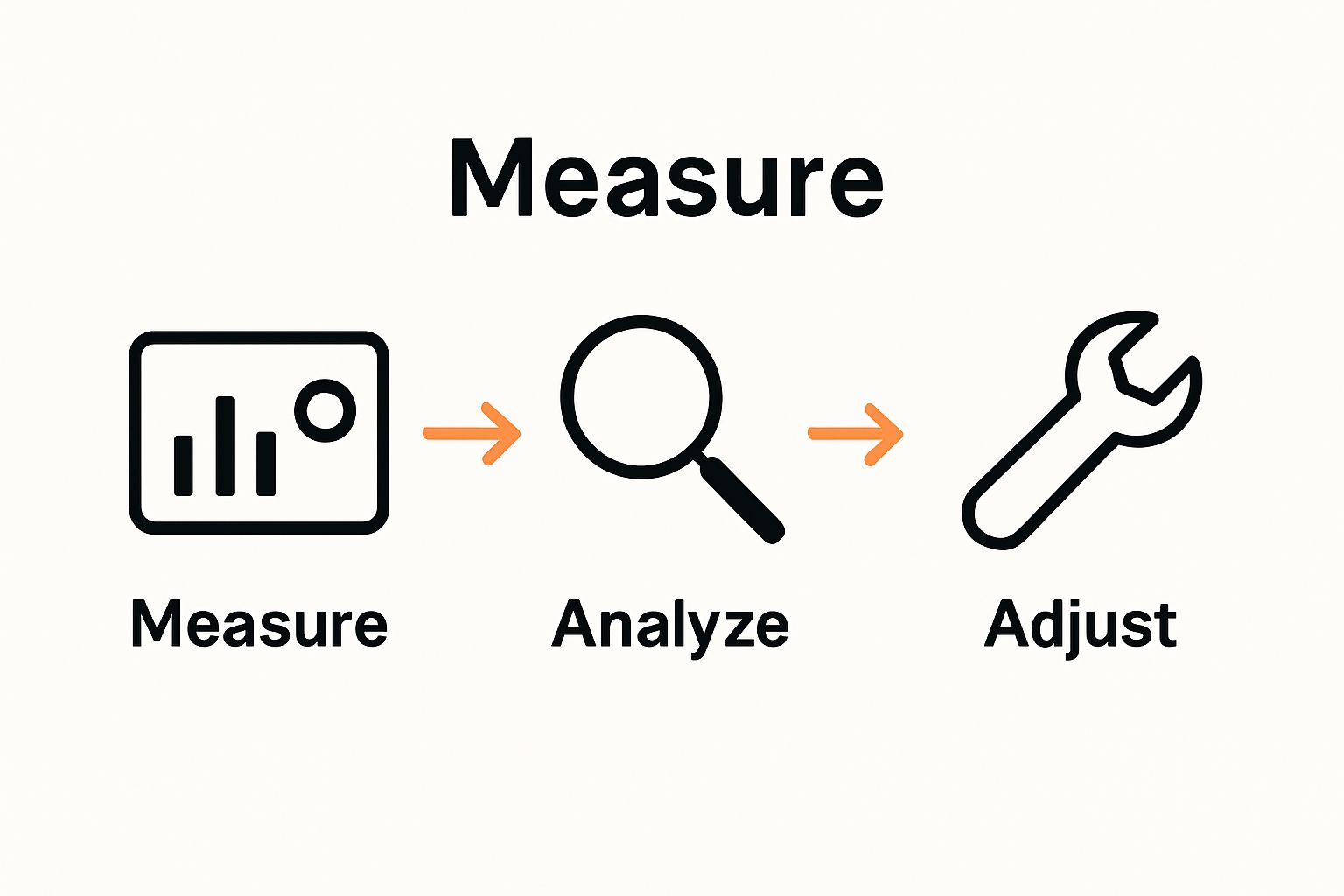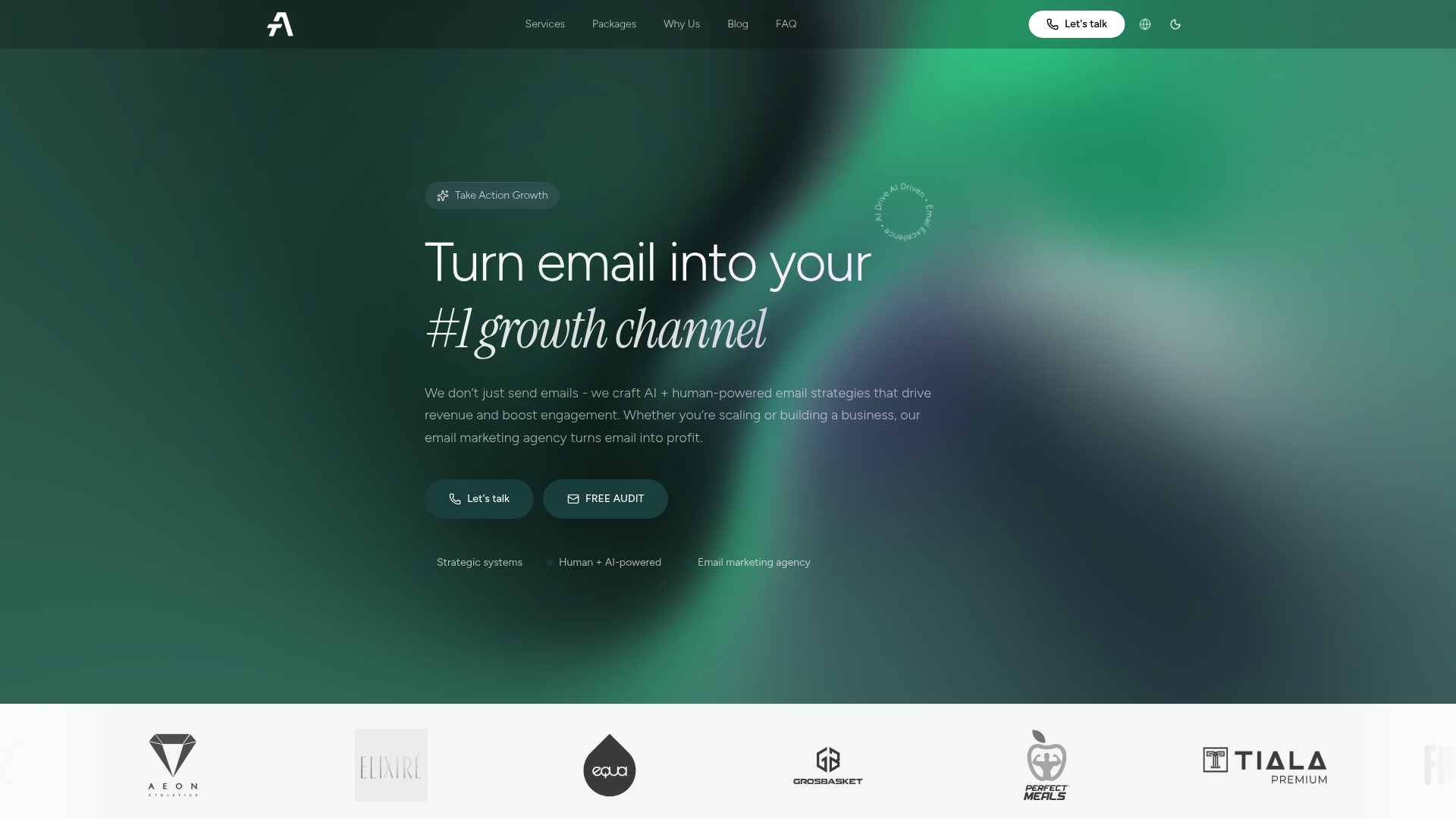How to Increase Conversions: Boost Sales with Proven Tactics
Most website owners want higher sales, but struggle to pinpoint what actually works. Here is a shocker. Nearly 70 percent of online shopping carts are abandoned before purchase. That means even small tweaks in your strategy can unlock huge growth you never expected.
Table of Contents
- Step 1: Analyze Your Current Conversion Metrics
- Step 2: Optimize Your Website For User Experience
- Step 3: Implement Targeted Email Campaigns With Klaviyo
- Step 4: Utilize A/B Testing For Continuous Improvement
- Step 5: Monitor And Adjust Based On Performance Data
Quick Summary
| Key Point | Explanation |
|---|---|
| 1. Analyze Conversion Metrics Thoroughly | Understand baseline metrics like conversion rates and cart abandonment to identify areas for improvement. |
| 2. Optimize Website User Experience | Ensure fast load times, intuitive navigation, and simplified checkout processes to enhance user engagement. |
| 3. Leverage Targeted Email Campaigns | Use Klaviyo to segment customers and automate tailored emails that nurture leads and boost conversions. |
| 4. Implement A/B Testing Regularly | Test variations in marketing elements to gain data-driven insights into what influences customer behavior effectively. |
| 5. Monitor Data Continuously for Insights | Regular analysis of performance metrics allows for timely adjustments to strategies based on customer trends. |
Step 1: Analyze Your Current Conversion Metrics
Increasing conversions begins with understanding your current performance landscape. Before implementing any strategic changes, you need a clear snapshot of how your existing sales funnel operates. This critical first step involves diving deep into your conversion metrics to establish a baseline that will guide all future optimization efforts.
To start, gather comprehensive data from your primary analytics platforms. Google Analytics and your ecommerce platform provide crucial insights into user behavior, conversion rates, and potential drop-off points. Focus on key metrics like website conversion rate, average order value, cart abandonment rate, and customer acquisition cost. Learn more about marketing analytics to understand the full spectrum of data available.
When analyzing these metrics, look beyond surface numbers. Track the entire customer journey from initial website visit to final purchase. Identify specific stages where potential customers exit or lose interest. Are users abandoning carts at checkout? Do they browse products but rarely complete purchases? Understanding these nuanced behaviors helps pinpoint precise areas requiring optimization.
Your conversion analysis should also segment data across different channels and customer demographics. Review performance variations between mobile and desktop users, examine conversion rates for different traffic sources like organic search, paid advertising, and email campaigns. This granular approach reveals targeted opportunities for improvement that generic strategies might miss.
To verify your analysis is comprehensive, confirm you have addressed these critical evaluation points:
Below is a checklist table organizing the key verification steps to ensure a thorough analysis of your current conversion metrics.
| Verification Step | Description |
|---|---|
| Website Traffic Volume | Measure the total number of visitors in a given period. |
| Conversion Rate per Traffic Source | Identify how each source (organic, paid, email) performs. |
| Bounce Rate for Key Landing Pages | Monitor percentage of visitors leaving without engagement. |
| Average Time Spent on Site | Analyze overall time users interact with your website. |
| Checkout Process Completion Rate | Track the percentage completing all checkout steps. |
- Total website traffic volume
- Conversion rate per traffic source
- Bounce rates for key landing pages
- Average time spent on site
- Checkout process completion rate
Remember, data tells a story. Your metrics are not just numbers but a roadmap guiding your conversion optimization strategy. By thoroughly understanding your current performance, you set the foundation for implementing targeted, effective improvements in the subsequent steps of this conversion enhancement journey.
Step 2: Optimize Your Website for User Experience
After establishing your baseline metrics, the next critical step is transforming your website into a conversion powerhouse through strategic user experience optimization. Your website serves as the digital storefront where potential customers decide whether to engage or exit, making its design and functionality paramount to increasing conversions.
Explore essential strategies for online sales that complement user experience improvements. Website optimization requires a holistic approach focusing on speed, navigation, visual clarity, and intuitive interaction design. Page load speed becomes your first fundamental target. Modern consumers expect websites to load within two seconds, with each additional second potentially costing you valuable conversions. Utilize tools like Google PageSpeed Insights to diagnose and eliminate performance bottlenecks. Compress images, leverage browser caching, and minimize complex scripts that slow down your site’s responsiveness.
Navigation plays an equally crucial role in user experience. Your website architecture should guide visitors seamlessly toward purchasing decisions. Create clear, logical menu structures that help users find products quickly. Simplify checkout processes by reducing form fields, offering guest checkout options, and displaying progress indicators. Implement prominent and visually appealing call-to-action buttons that stand out and clearly communicate the next step. Color psychology matters here technical choices like contrasting button colors can significantly influence click-through rates.
To verify your website optimization efforts have been successful, assess these critical performance indicators:
This checklist table summarizes essential performance indicators to measure the effectiveness of your website user experience optimization efforts.
| Performance Indicator | Success Benchmark or Description |
|---|---|
| Average Page Load Time | Should be under 2 seconds |
| Bounce Rate on Key Landing Pages | Lower rate indicates improved user engagement |
| Time Spent on Site | Increasing duration signals better user experience |
| Primary Call-to-Action Click-Through Rate | Higher rate reflects effective button design and placement |
| Mobile Responsiveness Metrics | Improved usability and functionality on mobile devices |
- Average page load time under 2 seconds
- Reduced bounce rates across key landing pages
- Increased time spent on site
- Higher click-through rates on primary call-to-action buttons
- Improved mobile responsiveness metrics
Remember that user experience optimization is an ongoing process. Continuously test different design elements, collect user feedback, and make incremental improvements. By creating a website that feels intuitive, fast, and user-friendly, you transform casual browsers into committed customers, setting the stage for increased conversions and sustained business growth.

Step 3: Implement Targeted Email Campaigns with Klaviyo
With your website optimized, the next powerful conversion strategy involves leveraging targeted email campaigns through Klaviyo. Email marketing remains one of the most effective channels for driving sales and nurturing customer relationships. Unlike generic mass communications, strategic email campaigns can transform casual browsers into loyal customers by delivering personalized, timely content that resonates with specific audience segments.
Explore essential ecommerce marketing strategies to complement your email approach. Begin by segmenting your email list based on critical customer attributes such as purchase history, browsing behavior, and engagement levels. Klaviyo provides sophisticated segmentation tools that enable you to create highly targeted communication streams.
For instance, develop distinct email flows for first-time purchasers, repeat customers, and users who have abandoned their shopping carts. Each segment receives messages tailored precisely to their stage in the customer journey.
Focus on creating automated email sequences that trigger based on specific customer actions. Welcome series for new subscribers should introduce your brand story and offer an incentive for their first purchase. Abandoned cart emails work best when sent within three hours of cart abandonment, featuring personalized product recommendations and potentially a time-limited discount. Post-purchase follow-up emails can include care instructions, complementary product suggestions, and requests for customer feedback. These strategic touchpoints not only increase immediate conversions but also build long-term customer loyalty.
To verify the effectiveness of your email campaigns, track these critical performance indicators:
- Email open rates above industry standard (typically 15-25%)
- Click-through rates demonstrating engagement
- Conversion rates from email-driven traffic
- Reduction in cart abandonment rates
- Increase in repeat customer purchases
Remember that successful email marketing is an ongoing process of testing, learning, and refining. Continuously experiment with subject lines, send times, and content personalization to discover what resonates most with your specific audience. By treating email not just as a communication channel but as a sophisticated conversion optimization tool, you can significantly boost your sales and create meaningful connections with your customers.
Step 4: Utilize A/B Testing for Continuous Improvement
A/B testing represents the scientific approach to conversion optimization, enabling you to make data driven decisions that incrementally improve your marketing performance. Think of A/B testing as a strategic experiment where small variations can yield significant insights into customer behavior and preferences. This methodical approach transforms guesswork into precise, actionable intelligence about what truly motivates your audience to convert.
Learn about scaling digital marketing strategies to complement your testing approach. Begin by identifying key elements to test across your digital ecosystem. Focus on high-impact areas like landing page design, email subject lines, call-to-action button colors, product descriptions, and checkout page layouts. Develop two versions of each element with a single strategic variation. For instance, test a green versus a red purchase button, or compare different headline phrasings that communicate the same core message. Ensure you test only one variable at a time to maintain clear, definitive results.
Utilize robust testing platforms like Google Optimize, Optimizely, or built-in tools within Klaviyo to systematically run your experiments. Allocate equal traffic between your control (original) and variant versions, and establish a statistically significant sample size before drawing conclusions. Typical tests should run for at least two weeks or until you achieve 95% confidence in the results. Pay close attention to metrics that directly impact conversions such as click-through rates, time on page, and ultimately, completed purchases. The goal is not just to make changes, but to understand the underlying customer psychology that drives those changes.
To verify the effectiveness of your A/B testing process, assess these critical performance indicators:
- Statistically significant improvements in conversion rates
- Clear understanding of which variations drive better performance
- Documented insights about customer preferences
- Quantifiable uplift in key performance metrics
- Repeatable testing methodology
Remember that A/B testing is an ongoing journey of continuous improvement. Each test provides a learning opportunity, gradually refining your understanding of what resonates with your audience. By adopting a systematic, data-driven approach, you transform your marketing from reactive guesswork to a precise, evolving strategy that consistently enhances customer engagement and drives sustainable growth.
Step 5: Monitor and Adjust Based on Performance Data
Successful conversion optimization is not a one time event but a continuous process of measurement, analysis, and strategic refinement. Performance monitoring transforms raw data into actionable insights that drive meaningful business growth. By establishing a systematic approach to tracking key metrics, you create a responsive strategy that adapts dynamically to changing customer behaviors and market conditions.
Explore strategies for boosting social shares to complement your performance tracking efforts. Start by consolidating your analytics from multiple platforms including Google Analytics, Klaviyo, and your ecommerce dashboard. Create a comprehensive dashboard that provides a holistic view of your key performance indicators. Focus on metrics that directly impact conversions such as traffic sources, bounce rates, average session duration, cart abandonment rates, and conversion funnels. Set up custom alerts that notify you of significant changes or potential issues in real time, enabling quick interventions before minor problems escalate.
Develop a consistent review schedule where you deeply analyze performance data weekly and conduct more comprehensive monthly assessments. During these reviews, look beyond surface level numbers to understand the underlying patterns and trends. Identify potential correlations between marketing activities and conversion rates. For instance, examine how specific email campaigns, social media interactions, or website changes correspond with shifts in customer engagement. Pay special attention to seasonal variations, emerging customer segments, and changes in purchasing behaviors that might require strategic adjustments to your conversion optimization approach.
To verify the effectiveness of your performance monitoring process, assess these critical indicators:
This table presents critical indicators to confirm your performance monitoring and adjustment process is effective and data-driven.
| Indicator | Description |
|---|---|
| Consistent Tracking of Key Metrics | Regular monitoring of conversion and related data |
| Documentation of Performance Insights | Keeping detailed records for strategy refinement |
| Adjustments Based on Data Analysis | Implementing changes based on observed patterns |
| Improvements in Conversion Rates | Quantifiable increases related to optimizations |
| Understanding of Customer Behavior Trends | Identifying shifts in user actions and preferences |
- Consistent tracking of key conversion metrics
- Regular documentation of performance insights
- Implemented adjustments based on data analysis
- Quantifiable improvements in conversion rates
- Clear understanding of customer behavior trends
Remember that data monitoring is not about perfection but continuous improvement. Each data point tells a story about your customers, and your ability to listen and respond determines your long term success. By maintaining a disciplined, curious approach to performance analysis, you transform raw numbers into a strategic roadmap for sustainable growth and increased conversions.

Ready to Turn Insights Into Measurable Growth?
You have taken the first steps by analyzing your data and refining your website. However, realizing consistent sales growth hinges on strategic email marketing that transforms one-time visitors into loyal customers. If you want to maximize your conversion rates and truly benefit from automated results, you need more than just tactics. You need a partner who can fuse your unique brand voice with proven campaign expertise, especially around Klaviyo and customer retention.

Imagine what happens when every touchpoint is personalized and every abandoned cart represents another saved sale. Visit Take Action now to see how we create sophisticated email strategies tailored for brands ready to scale. Let our expert team show you how segmentation, automation, and high-impact flows can recover revenue and unlock higher conversions. Start building your path to sustainable online sales growth today—connect with us for a custom Klaviyo blueprint and see immediate impact. Now is the ideal moment to move from analyzing metrics to making your data work for you.
Frequently Asked Questions
How can I analyze my website’s current conversion metrics?
To analyze your website’s current conversion metrics, gather data from analytics platforms like Google Analytics and your ecommerce platform. Focus on metrics such as website conversion rate, average order value, cart abandonment rate, and customer acquisition cost, while tracking the entire customer journey from first visit to purchase.
What are effective strategies for optimizing user experience on my website?
Effective strategies for optimizing user experience include improving page load speed to under two seconds, simplifying navigation, creating clear and intuitive menu structures, and enhancing the checkout process by minimizing form fields and providing guest checkout options. Use prominent call-to-action buttons to guide users toward conversions.
How can I use Klaviyo to implement targeted email campaigns?
You can use Klaviyo to implement targeted email campaigns by segmenting your email list based on customer attributes like purchase history and engagement levels. Create automated email sequences for different customer actions, such as welcome series for new subscribers and abandoned cart emails, to provide personalized content that drives conversions.
What is A/B testing and how can it improve my conversion rates?
A/B testing is a method where you compare two versions of an element (like a webpage or email) to determine which one performs better in terms of conversions. This testing approach helps you make data-driven decisions by understanding customer preferences, allowing you to refine marketing strategies systematically.
Recommended
- 7 Essential Ecommerce Marketing Strategies for Growth | Take Action Blog | Take Action
- What is Retargeting? Understanding Its Impact on Sales | Take Action Blog | Take Action
- 10 Proven Ways to Increase Online Sales in 2025 | Take Action Blog | Take Action
- 7 Essential Lead Generation Techniques for 2025 | Take Action Blog | Take Action
- Converting Website Traffic: Proven Strategies for 2025
